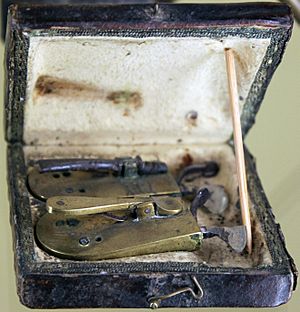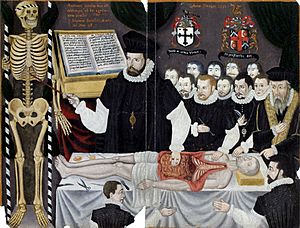Barber surgeon facts for kids


A barber surgeon was a special kind of medical helper in Europe during the Middle Ages. They were often the main people who took care of soldiers after battles. Back then, regular doctors usually didn't do surgery. Instead, barbers did these jobs.
Barbers were already good with razors and had steady hands. This made them useful for many tasks, from cutting hair to even removing body parts if needed.
Surgery was very dangerous in those days. Many people died from losing too much blood or from infections. Doctors at the time believed that removing blood, called bloodletting, could help cure illnesses. So, barbers also used leeches to take blood from patients.
Most doctors thought surgery was beneath them. They preferred to study at universities or work in castles, treating rich people. They would mostly just watch surgeries or give advice.
Contents
Barber Surgeons in the Middle Ages
Monks in monasteries had to keep their heads shaved in a special way called a tonsure. This meant monasteries needed barbers. These barbers started doing more than just cutting hair. They performed bloodletting, pulled teeth, and made healing creams. The first barber surgeons known by this name worked in monasteries around the year 1000 AD.
Since doctors rarely did surgery, many other people became medical helpers. These included people who fixed cataracts (eye problems), treated hernias, removed bladder stones, and helped with childbirth. In 1254, an Italian doctor named Bruno da Longobucco worried about barbers doing bloodletting and skin cuts.
Barbers in France and Italy
In Paris, arguments between doctors led to barbers becoming very popular. There was a medical school called the College of St. Cosme. It had two types of student doctors. Some wore long robes and were allowed to do surgeries. Others wore short robes and had to pass a special test to get their license. The short-robed doctors felt unfairly treated by the long-robed ones.
So, the short-robed doctors made a secret deal with the barber surgeons of Paris. They would teach the barber surgeons about human anatomy (how the body is built). In return, the barber surgeons promised to support them. This secret agreement lasted from about 1210 until 1499. That's when the barber surgeons asked for their own dead body to study anatomy.
From the 1540s in France, old medical books were translated into French. This helped barber surgeons learn more. They could combine their hands-on skills with ancient medical knowledge.
"If you want a servant to follow your orders, you can't give them in an unknown tongue."
New problems came up during wars. Wounds from firearms and injuries from artillery were different from anything seen before. Barber surgeons had to treat all injuries on the outside of the body. Doctors treated problems on the inside.
It was possible for barber surgeons to become full surgeons. A young surgeon often started by learning to shave. This gave them a way to earn money while they learned surgery. This practical training was very important. As Michel de Montaigne said,
“Surgery seems to me much more certain, because it sees and handles what it does; there is less to conjecture and guess.”
By 1660, barber surgeons finally accepted that doctors were in charge.
In Italy, barbers were not as common for medical tasks. Medical schools in Salerno, Bologna, and Padua taught doctors to be good surgeons. In Florence, doctors and surgeons were separate. But a law in 1349 gave barbers a lower legal status than surgeons.
Barbers in the British Isles

In England, barber surgeons were officially recognized in 1540. The Fellowship of Surgeons, who were trained by learning on the job, joined with the Company of Barbers. Together, they formed the Company of Barber-Surgeons.
However, doctors slowly took over more medical tasks. In 1745, the surgeons left the Barbers' Company. They formed their own group, the Company of Surgeons. In 1800, this group became the Royal College of Surgeons in London. Similar colleges were formed in Scotland and Ireland.
Modern Traditions
Today, there are very few signs of barbers' old link to surgery. One is the traditional red and white barber's pole. It is said to represent the blood and bandages from their past role.
Another tradition is how surgeons are addressed in the United Kingdom, Ireland, and some other countries. When doctors finish their surgery training, they are called "Mr" (or Miss, Mrs, Ms) instead of "Dr". This goes back to when surgeons didn't need a university degree in medicine. Even though all surgeons now have medical degrees and many years of training, this tradition remains. Barbers no longer perform surgeries; they just cut hair.
What Did a Barber Surgeon Do?
A barber surgeon could do many medical procedures. These included:
- Bloodletting (removing blood)
- Cupping therapy (using heated cups to create suction on the skin)
- Pulling teeth
- Amputating (removing) limbs
Barbers also gave baths, cut hair, shaved or trimmed facial hair, and gave enemas. During wars, they worked with the army. In peacetime, they helped regular people.
See also
 In Spanish: Barbero cirujano para niños
In Spanish: Barbero cirujano para niños

